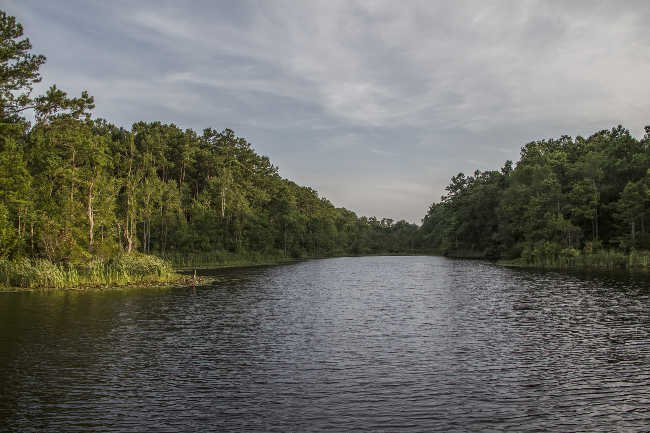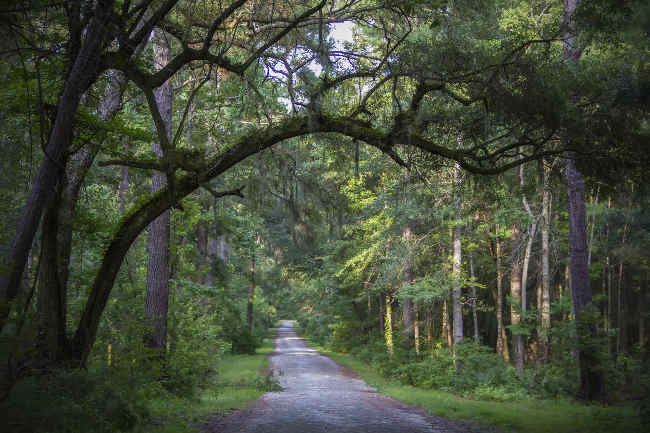Red Bank Plantation – Cooper River – Berkeley County
Basic Information
- Location – Cooper River, Goose Creek, Berkeley County
Redbank Road
- Origin of name – ?
- Other names – Marrington
- Current status – Location of Joint Base Charleston. Much of the property is maintained as a public recreational area but passes are required for use of the trails.

— Riverview at Red Bank/Marrington Plantation © Brandon Coffey, 2016 —
(Do Not Use Without Written Consent)
Timeline
- 1710 – Earliest known date of existence
Dr. Nathaniel Snow was issued a grant 400 acres by the Lord Proprietors. He soon added another 400 acres, including the 75 acre Snow's Island, to double the plantation's size. Dr. Snow farmed and made bricks on the property (1, p. 221) (3).
- ? – House built
- 1725 – Dr. Nathaniel Snow sold the 75 acre Snow's Island to his son, Nathaniel Snow Jr. (3).
- 1728 – Dr. Snow died. His will stipulated his son, William, was to sell the remaining 725 acres of Red Bank Plantation (3).
- 1729 – Dr. Snow's son William sold Red Bank to Alexander Nisbett (1, p. 221).
- 1733 – Nisbett sold the property to John Walker (1, p. 221).
- 1765 – Walker sold Red Bank to William Withers except for approximately 8 acres at the deep water of the river which was used as a landing. Red Bank Landing was critical for barges to load and unload (1, p. 221).
- Prior to 1797 – Peter and Mary Tamplett became owners (1, p. 221).
- ? – Aaron Loocock purchased Red Bank. At this time, the property still excluded Snow's Island and Red Bank Landing (1, p. 222).
- 1792 – Loocock sold 314 acres of Red Bank to Peter and Hanna Gray and the other section to Hugh Swinton. Swinton later purchased Snow Island and held a total of 666 of the original 800 ares of Red Bank (1, p. 222).
- 1795 – The Grays conveyed their 314 acres to son Benjamin Gray (1, p. 222).
- ? – John Bowen was the next owner of the smaller section of Red Bank (1, p. 222).
- ? – The next owner of the smaller part of Red Bank was Joseph H. Ramsey (1, p. 222).
- ? – William Tennent owned the 314 acre tract Red Bank (1, p. 222).
- Cicra 1803 – William Tennent formed a partnership with previous owner Joseph H. Ramsey. They purchased the larger section of Red Bank plus additional acreage in the area bringing Red Bank up to 966 acres (1, p. 224).
The Tennent and Ramsey families intermarried which lead to Red Bank be subdivided once again (1, p. 224).
- 1805 – Charles Tennent acquired 656 acres while William Tennent retained the other 356 acres (1, p. 224).
- 1813 – Alexander Kirk purchased the 356 acre tract (1, p. 225).
- 1856 – Mary Ramsey Tennent received as a gift from her father the 656 acre section (1, p. 224).
- 1871 – John Frederick Poppenheim purchased Brick Hope Plantation (then called Marrington Plantation) from the Graves family heirs. Poppenheim also owned Red Bank Plantation at this time. Both the Red Bank and Marrington names were used to describe Poppenheim's large estate (1, pp. 215, 225).
- 1880 – The census showed John Frederick Poppenheim owned and cultivated rice on the lands of Red Bank (1, p. 225).
- 1926 – Percy Orian Mead Sr. moved the area and began purchasing several pieces of land. He purchased most of the Marrington tract from Poppenheim and eventually ended up buying much of the traditional Red Bank / Marrington properties. Mead built a 32 room house with a dock on Goose Creek (1, p. 227).
- 1934 – Poppenheim died and willed 542 acres along the Cooper River to his daughter Ida Kodama "Poppenheim". Ida was not the Poppenheim's natural daughter, but the child of the Kodama family whom cultivated rice on the plantation. The Poppenheims raised Ida as their own although never legally adopted her. Poppenheim divided the rest of his Red Bank holding among the Kodama family (1, p. 227).
- ? – W.L. Stribling bought the estate from Mead to harvest the timber off the property (1, p. 227).
- ? – Stribling sold the plantation to Adolfus N. Mauncy after owning it for only a couple of years. Mauncy had been a business partner of Mead. Mead had persuaded his friend to purchase the property, which was referred to as Marrington at this time. Either Stribling or Mauncy built the Marrington house (1, p. 227).
- 1940s – Westvaco purchased both the Marrington and Red Bank properties. The Marrington house was used as a hunting lodge (1, p. 227).
- 1970s – Westvaco planned on building a paper mill along the river but the nearby US Navy installation was expanding and purchased the property for expansion and security of having the river as a boundary (1, p. 227).
- 1977 – The Marrington house, which the navy used as the Rod and Gun Club House, was destroyed in a fire (1, p. 227).
Land
- Number of acres – 400 in 1710; 800 in 1710; 725 in 1725; 717 in 1765; 966 in 1803
- Primary crop – Rice and cotton
- Primary crop – Rice and cotton
Slaves
- Number of slaves – ?
Buildings
- There were two houses on Red Bank in the late 1800s. The Red Bank house as well as the Marrington house (1, pp. 225-226).
References & Resources
- Michael J. Heitzler, Goose Creek: A Definitive History - Volume One: Planters, Politicians and Patriots
(Charleston, SC: The History Press, 2005)
- Henry A. M. Smith, The Historical Writings of Henry A.M. Smith
(Spartanburg, SC: Reprint Company, 1988)
 Order The Historical Writings of Henry A.M. Smith
Order The Historical Writings of Henry A.M. Smith
- Information provided by Charlet Poitevint Grace.
Contact Information
- Joint Base Charleston
Telephone: 843-963-5608; 843-764-7951
- Marrington Trail map - PDF



